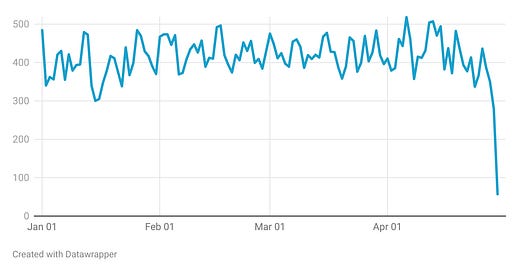The last few years have seen a boon for crime data being reported much faster than ever before at a state level. The number of states publishing data for the current year has never been higher, and as such I figured I’d put together a guide of which states publish the most up to date crime data.
One thing to be cautious of — especially when comparing YTD data — is that not all agencies have reported data for the most recent completed month. Also, sometimes those agencies underreport one month. And an agency may incompletely report a recently completed month because they’re still waiting on data from the last few days of the month.
Take the case of San Antonio. SAPD does a great job of pushing data to the Texas Department of Public Safety very early in a month, so in early June their figures for May will be updated. But, reviewing offense data by day shows that the last week or so of the most recently completed month is not complete. Those figures for May will be complete though when they report June figures in early July.
So in other words, be cautious when speaking definitively about data on official state UCR websites and look out for potential reporting quirks. But state UCR programs are an incredibly rich source of data providing insight into national trends as they develop if you can watch out for the potential pitfalls.
Let’s dig into the state UCR landscape!
Current Data
These states all publish 2024 data with minimal delay in releasing agency data. Not every agency participates in a timely fashion, but on the whole these states make data access easy. Most of the states use either Beyond 20/20 or Optimum Technology as their Records Management System while Minnesota publishes its own data.
Available Past 2022 But It’s Inconsistent Or Challenging To Access
These states have data for 2023 or even 2024, but the data is either difficult to find (Florida), largely incomplete (Mississippi), doesn’t go up to 2024 (Montana, Nebraska, and Ohio), or does come up to 2024 but it’s updated inconsistently with many missing agencies (Oregon and Utah).
Available Through 2022
Some of these states will publish 2023 data before the FBI’s UCR data comes out in October. Largely matches what is available through the FBI though some states have additional elements of crime data available. Wide variety of accessibility with some states having fully searchable data and others more limited PDFs.
Heavily Delayed
Data isn’t even available through 2022.
Nada
Indiana
Vermont




A couple of questions, Jeff:
* Typical of most data, the shorter the crime data timeframe, the less useful the analysis. IOW, daily, weekly, monthly data don't tell much of a story and can be more easily manipulated/misunderstood. Even year-over-year data has limits. The most meaningful basis for comparison is over 5, 10, even 20 years - in order to understand crime trends. Yet media crime articles are almost always short-term and largely anecdotal, focusing on individual (scary) events while failing to provide Big-Picture contextual analyses. I'm interested in your thoughts on this.
* The American public clearly has little objective understanding of actual crime rates, coupled with the fact that the press, including the MSM, does a dismal job of reporting on crime. Considering that certain politicians, and the "news" agencies that support those pols, have a vested interest in keeping the public unsettled about the threat of crime, the misconceptions are somewhat understandable. You tried to educate us in Glenn Thrush's 5/26/24 NYT article, but your comment was excerpted and buried deep.
What fascinates me is that so many of our citizens are determined that to believe that crime rates are high and that they are at personal risk of victimization, even when statistically, their odds of that are extremely low (excepting those who do live in the well-identified high crime zip codes). Commenters to Crime articles twist themselves in knots denying the reality that crime rates are generally historically low. They insist, inaccurately, that most law agencies don't report crimes, that gun laws (such as they are) aren't enforced, that "where I live crime isn't bad but over there in (XXX), it's dangerous", yada… What are your thoughts on this, also?
Realizing that DC isn’t a state, for these purposes how it treats crime data should still be included in this summary.